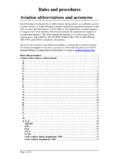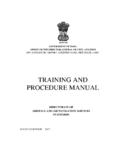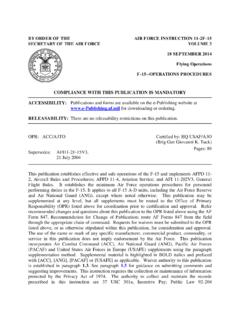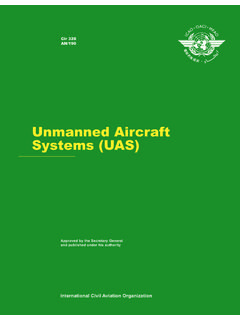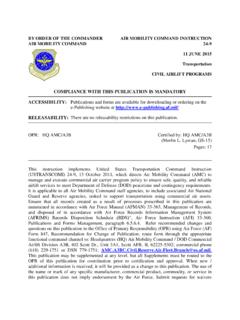Transcription of International Health Regulations (2005) - WHO
1 WHO/CDS/EPR/ International Health Regulations (2005) Areas of work for implementation June 2007 EPIDEMIC AND PANDEMIC ALERT AND RESPONSE International Health Regulations (2005): Areas of work for implementation WHO/CDS/EPR/ International Health Regulations (2005) Areas of work for implementation June 2007 International Health Regulations (2005): Areas of work for implementation World Health Organization 2007 All rights reserved. The designations employed and the presentation of the material in this publication do not imply the expression of any opinion whatsoever on the part of the World Health Organization concerning the legal status of any country, territory, city or area or of its authorities, or concerning the delimitation of its frontiers or boundaries.
2 Dotted lines on maps represent approximate border lines for which there may not yet be full agreement. The mention of specific companies or of certain manufacturers products does not imply that they are endorsed or recommended by the World Health Organization in preference to others of a similar nature that are not mentioned. Errors and omissions excepted, the names of proprietary products are distinguished by initial capital letters. All reasonable precautions have been taken by the World Health Organization to verify the information contained in this publication. However, the published material is being distributed without warranty of any kind, either expressed or implied. The responsibility for the interpretation and use of the material lies with the reader. In no event shall the World Health Organization be liable for damages arising from its use.
3 Printed in Lyon. International Health Regulations (2005): Areas of work for implementation - 1 -Contents 2 abbreviations and acronyms 5 Executive summary 9 Background 13 Vision and goals 17 Areas of work and expected results 17 Foster global partnerships 19 Strengthen national disease prevention, surveillance, control and response systems 21 Strengthen public Health security in travel and transport 23 Strengthen WHO global alert and response systems 25 Strengthen the management of specific risks 27 Sustain rights, obligations and procedures 28 Conduct studies and monitor progress International Health Regulations (2005): Areas of work for implementation - 2 - abbreviations and acronyms ACI Airports Council International ADB Asian Development Bank AFD Agence fran aise de d veloppement AFRO WHO Office for Africa APHA American Public Health Association APSED Asia Pacific Strategy for Emerging Diseases ASEAN Association of Southeast Asian Nations CDC Centers for Disease Control and Prevention CIDA Canadian International Development Agency DFID UK Department for International Development EU European Union FAO Food and Agriculture Organization GAVI The GAVI Alliance.
4 Formerly known as the Global Alliance for Vaccines and Immunization GOARN Global Outbreak Alert and Response Network IAEA International Atomic Energy Agency IANPHI International Association of National Public Health Institutes IATA International Air Transport Association ICAO International Civil Aviation Organization ICRC International Committee of the Red Cross IDSR Integrated Disease Surveillance and Response IFRC International Federation of Red Cross and Red Crescent Societies ISF International Shipping Federation ILO International Labour Organization IMO International Maritime Organization IHR (2005) International Health Regulations , 2005 revision IHR (1969) International Health Regulations , 1969 edition International Health Regulations (2005): Areas of work for implementation - 3 -JICA Japan International Cooperation Agency Mercosur Mercado Com n del Sur (Southern Common Market) MSF M decins sans frontiers (Doctors Without Borders) NGOs Nongovernmental organizations OIE World Organization for Animal Health SEARO WHO Regional Office for South-East Asia Sida Swedish International Development Cooperation Agency UIR Union of International Railways UN United Nations UNICEF United Nations Children s Fund UNWTO World Tourism Organization USAID United States Agency for International Development WHA World Health Assembly WPRO WHO Regional Office for the Western Pacific WTO World Trade Organization International Health Regulations (2005).
5 Areas of work for implementation - 4 - International Health Regulations (2005): Areas of work for implementation - 5 - Achieving International public Health security is one of the main challenges arising from the new and complex landscape of public Health . Shared vulnerability implies shared responsibility. Strengthening countries' disease surveillance and response systems is central to improving public Health security in each country and globally. WHO's unique public Health mandate, worldwide network, well established global partnership and long-standing experience in International disease control constitute an exceptional and unique asset for supporting countries in strengthening their capacity and for achieving International Health security. In June 2007, when the revised International Health Regulations (IHR) enter into force, the world will also have the necessary global framework to prevent, detect, assess and provide a coordinated response to events that may constitute a public Health emergency of International concern.
6 International public Health security relies on the appropriate and timely management of public Health risks, which in turn depend on effective national capacities and International and intersectoral collaboration. The IHR comprise a legal instrument specifically designed to support the attainment of this goal. Implementing IHR (2005) is an obligation for WHO and States Parties to the Regulations . A necessary commitment Meeting the requirements in the revised IHR (2005) is a challenge that requires time, commitment and the willingness to change. This paper has been developed to guide WHO Member States and other countries that are parties to the Regulations in the implementation of the obligations contained in them. Section 4 sets out seven areas of work to assist countries with the challenges inherent in meeting the new obligations.
7 Each area of work has a specific goal that contributes to the over-arching goal of International public Health security, and each area of work will be the subject of one or more detailed implementation plans. Four key areas of work Of the seven areas of work (see Table below) to guide IHR implementation, four of these (2, 3, 4 and 5) are key, as they call for significantly strengthened national and global efforts: 2 - Strengthen national disease surveillance, prevention, control and response systems and 3 - Strengthen public Health security in travel and transport, address countries' public Health capacities to fulfil IHR (2005) requirements. 4 - Strengthen WHO global alert and response systems and 5 - Strengthen the management of specific risks, focus on the necessary surveillance, prevention, control, and response systems at International level.
8 International Health Regulations (2005): Areas of work for implementation - 6 -Table Seven Areas of work to guide IHR (2005) implementation AREA OF WORK GOAL GLOBAL PARTNERSHIP 1. Foster global partnerships WHO, all countries and all relevant sectors ( Health , agriculture, travel, trade, education, defence) are aware of the new rules and collaborate to provide the best available technical support and, where needed, mobilize the necessary resources for effective implementation of IHR (2005). STRENGTHEN NATIONAL CAPACITY 2. Strengthen national disease prevention, surveillance, control and response systems Each country assesses its national resources in disease surveillance and response and develops national action plans to implement and meet IHR (2005) requirements, thus permitting rapid detection and response to the risk of International disease spread 3.
9 Strengthen public Health security in travel and transport The risk of International spread of disease is minimized through effective permanent public Health measures and response capacity at designated airports, ports and ground crossings in all countries. PREVENT AND RESPOND TO International PUBLIC Health EMERGENCIES 4. Strengthen WHO global alert and response systems Timely and effective coordinated response to International public Health risks and public Health emergencies of International concern. 5. Strengthen the management of specific risks Systematic International and national management of the risks known to threaten International Health security, such as influenza, meningitis, yellow fever, SARS, poliomyelitis, food contamination, chemical and radioactive substances. LEGAL ISSUES AND MONITORING 6.
10 Sustain rights, obligations and procedures New legal mechanisms as set out in the Regulations are fully developed, and upheld; all professionals involved in implementing IHR (2005) have a clear understanding of, and sustain, the new rights, obligations and procedures laid out in the Regulations . 7. Conduct studies and monitor progress Indicators are identified and collected regularly to monitor and evaluate IHR (2005) implementation at national and International level. WHO Secretariat reports on progress to the World Health Assembly. Specific studies are proposed to facilitate and improve implementation of the Regulations . Areas of work in line with WHO strategy This paper sets out expected results over the next five years and identifies national, International , and WHO institutional capacities that are vital to successfully implement the revised Regulations .










